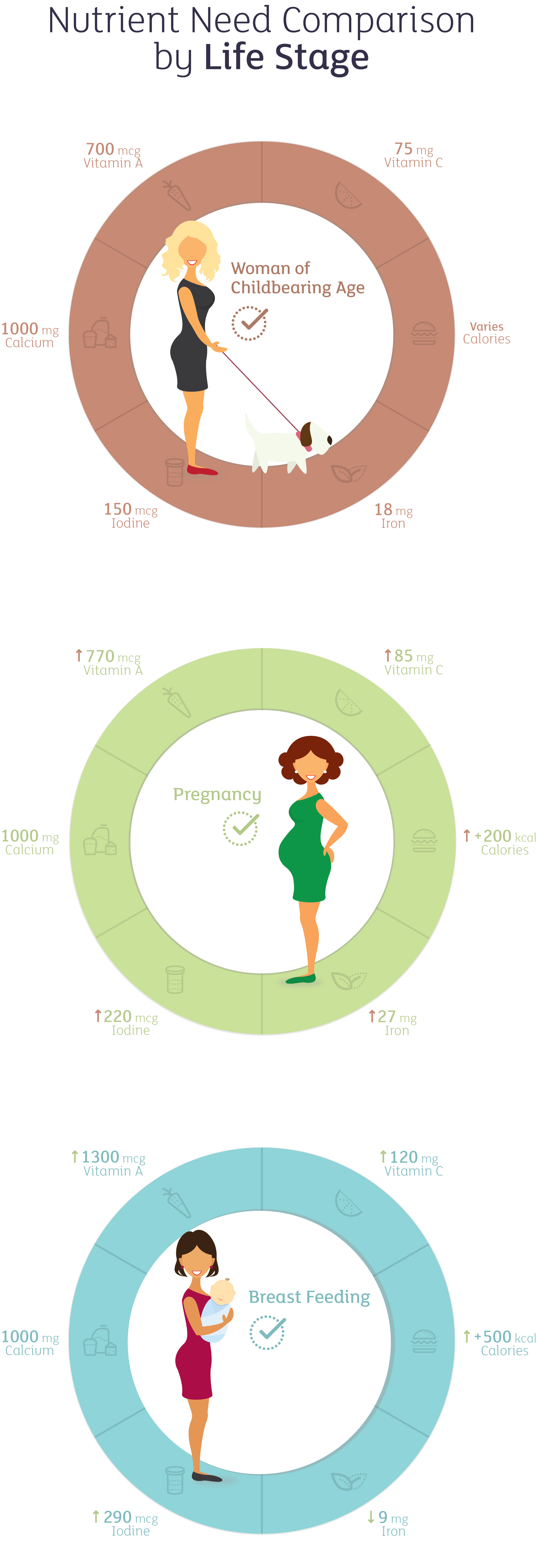 The first 1,000 days of a child’s life – beginning with conception through the first two years of childhood – critically impact development and health throughout life. Because of the high prevalence of low birth weight and undernutrition in childhood in developing countries, the United Nations (UN) Millennium Development Goals include the health of mothers. During pregnancy and lactation, the child is completely dependent upon the mother for nutrients. In order to care for the child, then, it is crucial to care for the mother.
The first 1,000 days of a child’s life – beginning with conception through the first two years of childhood – critically impact development and health throughout life. Because of the high prevalence of low birth weight and undernutrition in childhood in developing countries, the United Nations (UN) Millennium Development Goals include the health of mothers. During pregnancy and lactation, the child is completely dependent upon the mother for nutrients. In order to care for the child, then, it is crucial to care for the mother.
Pregnant women have unique dietary challenges that can be met with tailored solutions
Weight gain during pregnancy impacts maternal health, pregnancy outcomes such as preterm delivery or low birth weight, and child health after delivery. While all women require increased calories during pregnancy, recommended weight gain differs depending on pre-pregnancy weight status; underweight women should gain more weight than normal weight women while overweight and obese women should gain less. Inadequate maternal weight gain potentially harms the health of both mother and child since there may not be enough calories to support proper development in the womb. Obesity and excess weight gain increase the risk of stillbirth, preterm birth, birth defects, a large baby, and childhood obesity. Health organizations and government agencies around the world, including the U.S. Department of Agriculture, the U.K. National Health Service, and the Vietnam Ministry of Health, offer guidance to pregnant women on what and how much to eat to manage their weight and nutrition status. Weight gain is typically monitored by a physician, as well.

Vitamin and mineral needs can vary greatly between pre-pregnancy, pregnancy, and lactation and these nutrients can be just as important as calories (see infographic). A carefully chosen diet can meet recommendations for most nutrients, but the diets of pregnant and lactating women often fall short of many of these essential nutrients. This commonly leads to supplement recommendations by physicians, but it is also possible to help women in these life stages meet their dietary needs through targeted product development. Among the nutrients important to and under-consumed by most pregnant women are folic acid to help protect against neural tube defects, choline for fetal brain and nervous system development, iron for increased maternal and fetal blood volume, and calcium for bone growth and reduced risk of maternal hypertension. Other frequently supplemented nutrients include the fatty acids DHA and EPA, vitamin D, and iodine. Foods which supply these nutrients and also appeal to the unique tastes and values of pregnant women can go a long way in ensuring a healthy mom and baby.
In parts of the world where maternal malnutrition is common, supplementation becomes more critical to ensure proper fetal development during pregnancy. Calorie, protein, vitamin A, and iron may be available in a wide range of forms for pregnant and lactating women e.g. fortified dairy and non-dairy beverages, nutritional milks, nursing teas, and fortified cereals. – Fortification of staple foods with iron and folate can help decrease risk of deficiency at conception, but this type of public health initiative must be targeted to the specific population to determine the ideal fortification levels and mode of delivery. For example, many countries in Latin America fortify wheat or maize flour with iron, while Vietnam chooses to fortify soy sauce and fish sauce.
For the mother, most nutrient needs increase after delivery to support lactation
During lactation, the mother is able to provide all of a child’s nutrient needs via breastfeeding. For optimal health of the infant, the World Health Organization (WHO) and other global health organizations recommend exclusive breastfeeding for the first six months. For the mother, this means that the required intake for many nutrients becomes even greater than during pregnancy – after all, the baby is still totally dependent on the mother for nutrition, but it is now bigger than it has ever been! As a result, it is essential for the mother to eat a balanced diet during this time to ensure both she and her baby are healthy. For some nutrients, the mother’s body will ensure the breast milk contains enough for the baby even at the risk of depleting her own body’s reserves. These are mostly nutrients that are absolutely essential for proper growth and development of the baby, such as energy, protein, calcium, and zinc. Inadequate intakes by the mother could lead to higher risk of iron deficiency, anemia or loss of bone mineral density.
For other nutrients, breast milk concentration will vary depending on how much the mother is eating in her diet. Examples include iodine and choline, which are essential for cognitive development of the infant, and most vitamins. The mother is able to deliver more of these nutrients to her baby if she eats more in her own diet, but risks not delivering enough for her baby to properly develop if her own diet is inadequate. This means that to ensure both mother and her baby stay healthy, the importance of proper nutrition does not stop once the baby is delivered.
Although strongly encouraged, breastfeeding may not always be feasible. Infants who are not breast fed should receive an infant formula that resembles human milk as closely as possible. Developments in infant milk formula in recent years allows it to resemble human milk more closely than ever. Read our white paper Delivering Nutrition as Nature Intended to find out more.
Appropriate complementary feeding practices after the first six months support the health of the young child and convey long-term health benefits. For example, adequate calories can help manage weight gain during the first years of life while also lowering the risk of childhood obesity from overfeeding. Choosing foods rich in Vitamin A and iron will help support proper development of the child’s vision, immune system, and physical growth. In developing countries, WHO, UNICEF, and others also recommend supplementation or fortification with multiple micronutrient powders and individual nutrients to reduce infant and child mortality and improve growth and development.
Complementary feeding can be complicated by picky eaters. Read our blog Turning Fussy Young Eaters Into Foodies to learn about the importance of early, frequent exposures of healthy foods for lifelong health.

A child’s first 1,000 days set the course for lifelong health, with mothers in charge of the most important actions:
- Appropriate weight gain during pregnancy
- A nutritionally sound diet through pregnancy and lactation, including supplementation when indicated
- Exclusive breastfeeding for the first six months; if not feasible, selection of an appropriate infant formula
- Appropriate complementary feeding, including supplementation as directed by health care professionals
Increased nutrient needs aren’t the only challenge for pregnant and lactating women
Despite the importance of a balanced, healthy diet during pregnancy and lactation, these life stages can also be some of the most stressful and hectic years of life. Taking time to plan, shop for, and prepare healthy meals may be unrealistic, making reliance on pre-prepared meals and snacks increasingly common. To help mothers meet the needs of both her and her baby, tailored solutions rich in micronutrients specific to the needs pregnancy or lactation could go a long way in improving health. Foods tailored for pregnant women should emphasize iron and folate, while foods tailored for breastfeeding women could provide more vitamin A and iodine than those targeted at pregnant women. It is important to remember, though, that both of these life stages have increased nutrient needs compared to women of childbearing age, so all foods targeted toward pregnant or lactating women should be rich in vitamins and minerals.![]()

 Mindy Hermann, MBA, RDN specializes in food and nutrition communications for the industry, health professionals, and consumers. Mindy is a popular speaker and author on healthy eating at all ages. She served as a spokesperson for the Academy of Nutrition and Dietetics and has frequently appeared on national and local television.
Mindy Hermann, MBA, RDN specializes in food and nutrition communications for the industry, health professionals, and consumers. Mindy is a popular speaker and author on healthy eating at all ages. She served as a spokesperson for the Academy of Nutrition and Dietetics and has frequently appeared on national and local television. 